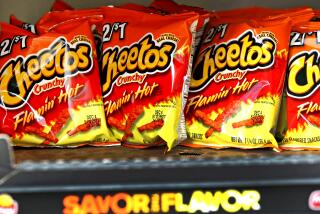Candy-like laundry pods pose poisoning threat to kids, doctors warn
Laundry detergent pods have quickly become a serious poisoning threat to young children, causing thousands of American kids to vomit, choke or suffer more serious symptoms since the products went on sale in the U.S. in early 2012, a new study warns.
At least 769 children younger than 6 were hospitalized in 2012 and 2013 after ingesting or handling laundry pods, which have appealing designs that resemble large pieces of candy. At least one infant -- a 7-month-old boy from Kissimmee, Fla. -- died as a result of laundry pod exposure.
Altogether, more than 17,230 young children have had potentially toxic encounters with laundry pods, and more than one-third of them required treatment at medical facilities, researchers found. That works out to 3.67 cases for every 10,000 U.S. children younger than 6.
The data, published Monday by the journal Pediatrics, come from the National Poison Data System, which tallies information on calls made to poison control centers throughout the country in 2012 and 2013. Since some children who were harmed by laundry pods probably went straight to their own doctors, the numbers in the study understate the products’ true dangers, the authors wrote.
One- and 2-year-olds were the most vulnerable to injury from laundry pods, with children in each age group accounting for about one-third of the total calls. “These ages represent a developmental period of newfound mobility, exploration, curiosity, and teething,” the researchers wrote. Toddlers in this age group are also likely to put things in their mouths, they added.
The most common health problem associated with laundry pods was vomiting, which occurred in 48% of cases reported to poison control centers. In addition, 13.3% of cases involved coughing or choking; 10.9% caused eye irritation or pain; 7% made children drowsy or lethargic; and 6.7% caused conjunctivitis.
A few dozen children had much more serious problems, including 30 who became comatose, 12 who had seizures, 11 who threw up blood, six with excess fluid in their lungs, five with a dangerously slow heartbeat, four with respiratory arrest and two with gastric burns. In addition to the death of the 7-month-old infant, laundry pods are suspected in the death of a 16-month-old toddler whose case is still under review, according to the study.
Most victims -- 75.1% -- were treated by having the detergent diluted or washed away, the data show. However, breathing tubes were required to treat 102 children.
Among all of the calls over the two-year period, 35.4% wound up getting treatment at a doctors’ offices, urgent care centers, emergency rooms or other healthcare facilities. Another 4.4% were admitted to hospitals, including 2% who received treatment in critical care units. Only 53.5% of cases were resolved over the phone, which is much lower than the 85.4% rate for all poison control center calls involving kids younger than 6, the study authors noted.
In March 2012, when laundry pods were new to the U.S. market, poison control centers fielded 137 calls related to the products. By April 2013, the monthly tally had spiked to 1,021 -- a 645% increase. After holding steady for a few months, they then dropped 24.4% between August and December of 2013, the researchers found.
That drop may have been triggered in part by increased public awareness of laundry pod dangers after the Florida infant’s death in August 2013, the study authors wrote. Previously, parents and other caregivers were not necessarily diligent about keeping the pods out of children’s reach. Among the 904 cases in which officials learned how the kids got their hands on the pods, the pod containers were “stored within sight of the child or always left out” 42.3% of the time. In another 15.1% of cases, the containers were “stored inappropriately” or kept in a “low unlocked kitchen or bathroom cabinet.” Finally, in 10.7% of cases, children got into the pods when the container was “temporarily” open and caregivers were “momentarily distracted.”
The researchers also noted that packaging changes introduced by Procter & Gamble (manufacturer of the top-selling Tide Pods) in the spring of 2013 could help explain why calls to poison control centers leveled off after April. These changes included a warning label, additional latches and an opaque container that blocked kids’ view of the candy-shaped pods. (A Tide website offers tips for keeping laundry rooms safe for kids.)
But more should be done to reduce the risk further, the study authors insist.
“It is not clear that the pod containers of any brand currently on the market are truly child resistant,” they wrote. “Standards are needed to help ensure that all manufacturers of laundry detergent pods adopt safer packaging for their products to decrease child exposure.” ASTM International (formerly the American Society for Testing and Materials) is already working on such standards, the researchers noted.
It’s also possible that the laundry pods themselves could be made less toxic. The makers of fabric cleaners were able to replace benzene with compounds called aliphatic chlorinated hydrocarbons without sacrificing any drop in quality, the researchers said.
The American Assn. of Poison Control Centers offers guidance on the safe handling of laundry detergent pods here.
For more health news, follow me on Twitter @LATkarenkaplan and “like” Los Angeles Times Science & Health on Facebook.







